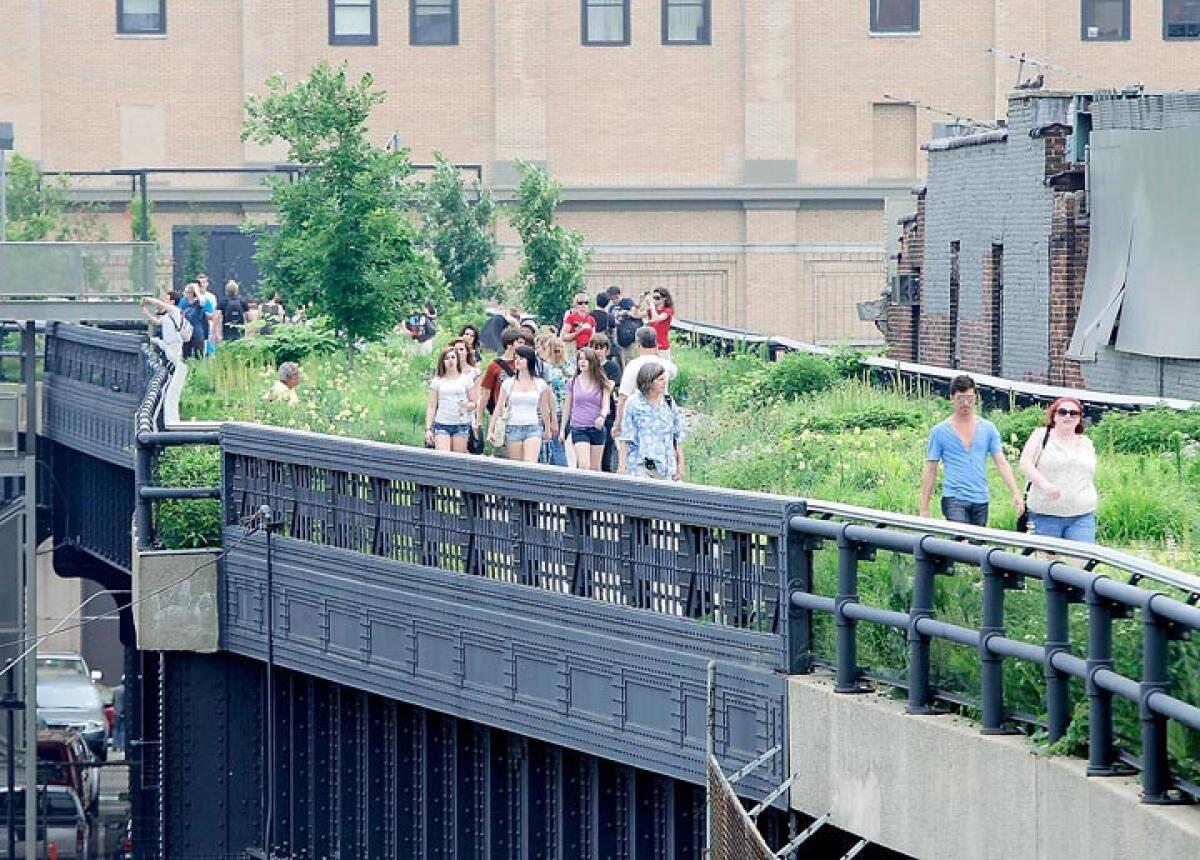Op-Ed: Freeway cap parks can be L.A.’s High Line

New York’s High Line park, seen here in 2011, has become one of the top visitor attractions in the city. The popular park was built along an abandoned elevated train line in Manhattan.
- Share via
On a perch above 10 lanes of freeway traffic, dogs chase Frisbees, kids frolic, boot-campers sweat and barbecues smoke. Glendale recently unveiled its plan for a freeway cap park called Space 134 with just such idyllic imagery.
Glendale’s proposal may strike some as an urban pipe dream, completely infeasible and unaffordable. No doubt, such projects demand substantial fundraising efforts, take a long time to build and require intensive coordination by multiple agencies. But Southern California cities must reach in this direction. If we don’t proactively create new open spaces as the L.A. metro area becomes more dense, livability here will take a turn for the worse.
Cap parks ... are nothing new. Seattle opened one in 1976 that spans 5.2 acres. Phoenix, Sacramento and Dallas (since 2012) are also in the game.
Cap parks — typically built at street level over the wide spans of below-grade highways — are nothing new. Seattle opened one in 1976 that spans 5.2 acres. Phoenix, Sacramento and Dallas (since 2012) are also in the game. These man-made spaces recapture unused airspace, typically in a central and pedestrian-accessible spot. They also create land bridges across our concrete rivers of cars, reconnecting neighborhoods.
In downtown Los Angeles, a cap park is planned across the 101 Freeway between Hope and Alameda streets — essentially reconnecting Chinatown and Olvera Street to Bunker Hill and the Civic Center. Another proposal for the 101 would cover the span from Santa Monica Boulevard to Hollywood Boulevard. The latter is closer to realization: Its environmental review process (started in 2008) is nearly complete, and the nonprofit Friends of the Hollywood Central Park has attracted some big donors and grants. The price tag may ultimately determine whether it is built. Feasibility studies peg the cost at $949 million, but other estimates suggest it could cost well over $1 billion.
Still, studies show that upgrades to highway infrastructure for cap parks don’t cost more — and often cost less — than comparably scaled highway improvement projects like widening. It cost $1.14 billion just to add a carpool lane to the 405, after all, and we didn’t even get a park out of that endeavor.
All of the cap park proposals under review in Los Angeles are, not coincidentally, in areas where high-density housing is becoming the norm, and where transit-oriented development is underway or planned. Despite a desire by some neighborhood groups for a moratorium on big residential developments, the Los Angeles region is desperate for more housing and increased density is unavoidable. Mayor Eric Garcetti pledged 100,000 new market-rate or below-market-rate homes by 2021, and the Goldhirsh Foundation’s LA2050 report cited a need for 500,000 additional housing units in the next 35 years. Small-lot subdivisions, high-amenity condominiums and compact-footprint town homes will all be needed if Los Angeles is to keep up with its population growth without bursting beyond our exurbs.
Los Angeles, of course, is not the first city to wrestle with questions of sudden density and open space. Between 1815 and 1840, when the population of Paris doubled, radical new plans were drawn to rebuild that city. Paris’ master planners laid out open spaces in each of the 80 neighborhoods for public gatherings and recreation (and, on a more sinister level, to control crowds and protests). No resident was more than a 10-minute walk from such an amenity.
Paris’ city parks were — and are — an antidote to dense urban living. They cultivated a sense of neighborhood identity within the larger city. They offered fresh air and sunlight to the individual and a central hub of public life for the overall health of the body politic.
Here in L.A., parks close to dense housing clusters need to fulfill a similar duty. But we don’t suffer under the iron fist of an emperor or king: In Paris, planners simply sliced up quartiers at will to carve out green space. Today’s urban planners have to identify latent potential in existing “leftover” spaces. West Manhattan’s wildly popular High Line park project — the conversion of a derelict, elevated section of New York Central Railroad into a park — is perhaps the best-known successful infrastructure reuse project of recent years.
Southern California’s most prominent type of infrastructure provides an even greater opportunity. Turning our concrete chasms into recreation meccas won’t be simple. But with thoughtful design and execution, cap park projects can make a more dense city beautiful and livable. L.A.’s next makeover is already underway, and it shouldn’t make us more park poor than we are already.
Wendy Gilmartin is a partner in the architecture firm Frohn&Rojas as well as a writer and lecturer in the department of architecture at Cal Poly Pomona.
Follow the Opinion section on Twitter @latimesopinion and Facebook
More to Read
A cure for the common opinion
Get thought-provoking perspectives with our weekly newsletter.
You may occasionally receive promotional content from the Los Angeles Times.









